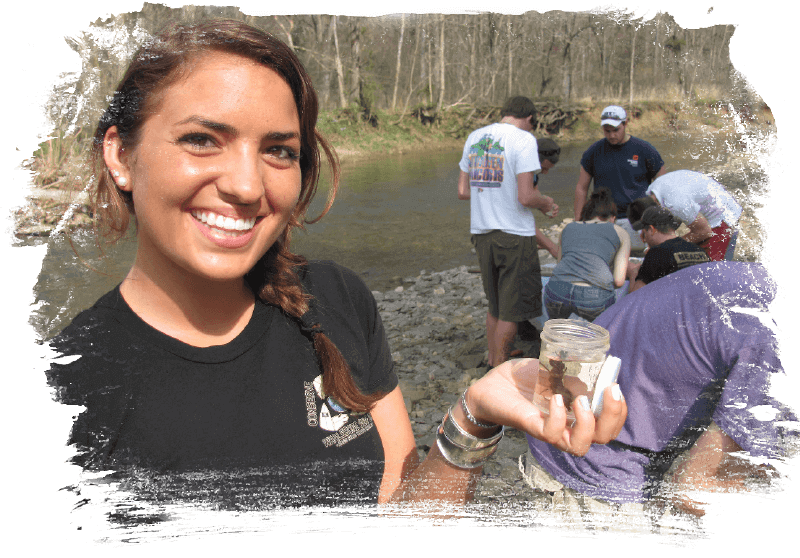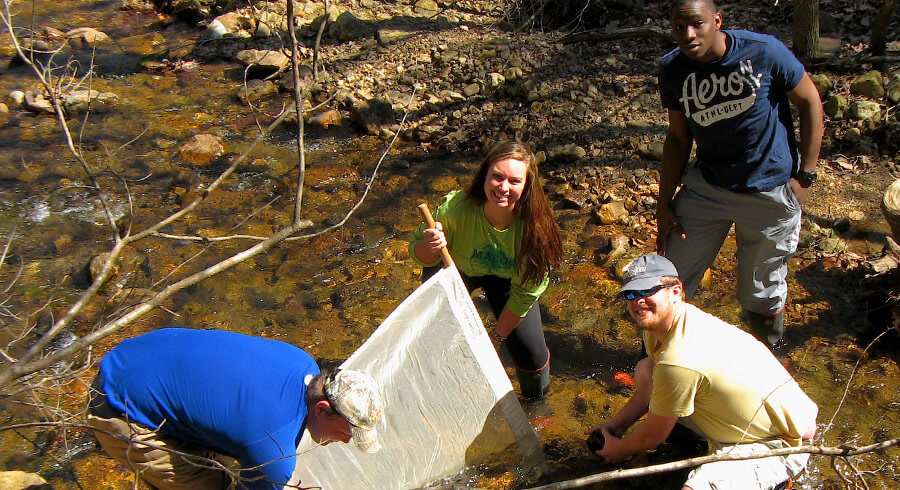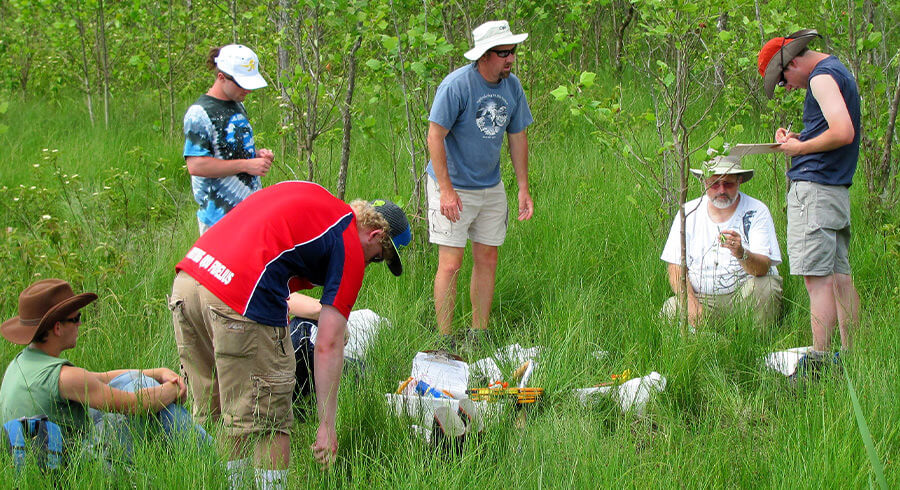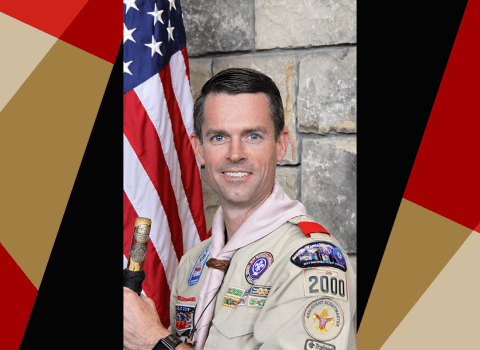On any day of the week, if you’re looking for where Professor of Environmental Studies and Biology Woodward “Woody” Bousquet, Ph.D., teaches classes, there’s a good chance you may need to reconsider your definition of “learning spaces.” That’s because Dr. Bousquet — and his students — may be found wading knee-deep in Abrams Creek collecting aquatic samples, examining rock formations and identifying native trees at the Shenandoah River Campus at Cool Spring Battlefield or assessing water quality in Cedar Creek.
Now in its 25th year, Shenandoah University’s environmental studies program uses the abundant outdoor resources of the Northern Shenandoah Valley as an interconnected learning laboratory for exploring important issues, methods and concepts. Students often work side-by-side with their professors, conducting research, publishing results and developing educational materials that help individuals and communities to better understand the natural world. Graduates leave Shenandoah ready to enter the workforce as environmental scientists or environmental educators in the government, conservation organizations or private firms interested in environmental issues.
Early Beginnings
Shenandoah University’s environmental studies program launched in 1991 under the leadership of Robert Bardwell, Ph.D., who served as program chair and faculty member in biology until his death in 1992. While the program began as a double major with biology, it later became a stand-alone major in the spring of 1994.
Dr. Bousquet, who joined the faculty in 1993 as associate professor of environmental studies and biology, has spearheaded the environmental studies program for more than 20 years. Together he and Associate Professor of Environmental Studies and Geography Joshua Kincaid, Ph.D., who joined the faculty in 2008, train and inspire students to look critically at environmental issues and to question how society works.
“Reaching this milestone of 25 years is such a tribute to the leadership and dedication of our faculty,” said Dean of the College of Arts & Sciences Jeffrey Coker, Ph.D. “Professors Woody Bousquet and Josh Kincaid continue to broaden and enhance a program that offers students a truly hands-on academic experience that prepares them for a wide array of possible career paths. It also serves our community and region in such critical ways.”
How many peer institutions can claim their environmental studies undergraduates’ efforts shaped a National Park’s master plan or led a city to establish its first nature preserve?” — Woody Bousquet, Ph.D.
Unique Aspects of the Program
Housed in the College of Arts & Sciences, this interdisciplinary program draws on courses from the natural sciences, the social sciences and the humanities to prepare students as practitioners able to investigate and address complex environmental problems. Research is such a critical component of the curriculum yet, according to Bousquet, many institutions limit research opportunities to a few top academic performers. That’s definitely not the case at Shenandoah.
“All our undergraduates have the chance to develop research skills and list their experiences on their resumes and in graduate school applications,” he said. “Students who are particularly interested and capable can find even further opportunities for research.”
Hands-on, career-related service-learning experiences provide an additional benefit to the program.

“Most environmental studies programs offer short-term service-learning, while many of Shenandoah’s environment-related service projects are much more substantive and extensive,” said Bousquet. “We build extended service-learning projects into several courses, such as ES 340 (Environmental Education) and ES 419 (Community & Regional Studies). By collaborating with government agencies and citizens’ groups, our projects address clearly identified needs, and the impacts extend beyond the duration of a single semester,” he said. “How many peer institutions can claim their environmental studies undergraduates’ efforts shaped a National Park’s master plan or led a city to establish its first nature preserve? While incorporating service-learning into our courses was the faculty’s idea, it has been the willingness — usually, the eagerness — of our students to use their knowledge, passion and energy to make a difference that has made so many accomplishments happen.”
Nearly all environmental studies programs utilize their surroundings for field studies, but Shenandoah’s 195-acre Cool Spring River Campus is a dedicated place where students and faculty can roll up their sleeves and collaborate.
“Shenandoah’s River Campus provides extensive opportunities for field trips, ecological restoration and research,” said Bousquet. “We also utilize Abrams Creek, rain gardens and native plantings on the main campus; several local parks; Winchester’s Abrams Creek and Shawnee Springs preserves; nearby Cedar and Opequon creeks; the Shenandoah River and places farther away. And while other institutions have curtailed field learning in the face of tightening budgets, having vehicles and funds available for student travel helps to make these opportunities possible.”


Making a Meaningful Difference
Bousquet cites several examples where academic and hands-on research has made a difference locally and in the region. For example:
- More than 20 environmental studies undergraduates presented their research at annual conferences of the Virginia Academy of Science.
- The City of Winchester, the Lord Fairfax Soil and Water Conservation District and the Princeton Review’s green colleges guide recognized the university’s efforts in environmental stewardship, sustainability and undergraduate education.
- The Mason-Dixon Outdoor Writers Association acknowledged students and faculty with its Grassroots Conservation Award in 2013.
“Perhaps the accomplishment with the most lasting effect on our community and region is the involvement of our students and faculty with the Abrams Creek Wetlands since 1997,” said Bousquet.
Located just two miles from main campus on the Winchester-Frederick County line, the site features rare marsh habitats, home to more than 20 plant species listed on Virginia’s rare plant list.
“Shenandoah’s environmental studies undergraduates and faculty investigated the wetlands, presented their findings to citizens and decision-makers, led field trips for children and adults and developed interpretive signs to help people appreciate the property’s significance. These efforts resulted in the dedication of the Abrams Creek Wetlands Preserve in 2003. The site was the City of Winchester’s first formally protected natural area. Each day, rain or shine, dozens of local residents and tourists come to the wetlands for exercise, nature study, family fun and inspiration.”
Students, faculty and alumni of Shenandoah’s environmental studies program — where curiosity and science meet a passion for the outdoors — can be proud of how their work over 25 years has contributed to the science of discovery and to the day-to-day lives of so many others.






